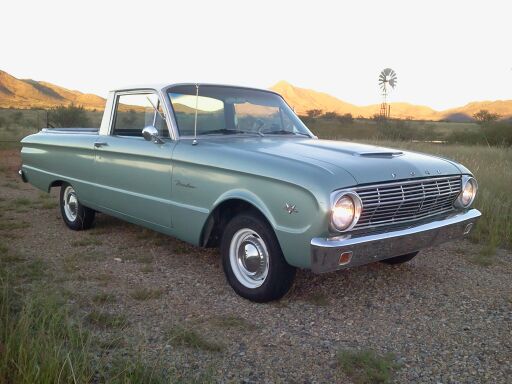
The Ford Ranchero made its debut at the New York Auto Show on this day in 1956. This car/truck mashup was a new type of automobile in the American market, but had sold steadily overseas for years. Years before the Ranchero came to market, the idea for the car/truck came from Ford Australian designer Lew Brandt. Inspired by a farmer looking for a vehicle to drive to church on Sundays and haul pigs on Mondays, Brandt grafted a bed into the body of the existing 1934 sedan models. The Ute, as it came to be known, remains a popular body style in Australia and elsewhere around the globe. In the USA domestic market, the most recent attempts to sell a similar vehicle includes the Chevrolet SSR, designed by Brian Baker, and the Subaru Baja, one of which this author proudly owns.
Ford based the 1957 Ranchero on the full size Ford Ranch wagon and Courier sedan delivery. Featuring an integrated cab and reinforced bed, the Ranchero offered the driveability of a car with the cargo capacity of a small pickup. This led to the marketing phrase, “More than a car, more than a truck.” It proved to be a popular model. It sold well enough that General Motors released its own version for 1959 with the Chevrolet El Camino.

Top: 1957 Ford Ranchero. By hugo90 – CC BY 2.0
Ford Falcon Ranchero
In 1960 Ford reduced the Ranchero’s footprint, instead basing it off of the compact Falcon. Increasing competition from imports such as the VW Beetle prompted the move to the smaller platform. Coming out of the late 1950s recession, many automotive consumers reported an interested in better fuel economy and lower pricing. Now standard with an inline 6, opposed to only V8 options in its predecessors, the lightweight Falcon Ranchero hit its mark. Interestingly, Chevrolet seemed unprepared. Chevy discontinued its full-size model following 1960 until 1964, giving Ford run of the market.
Starting in 1966 the Ranchero became a mid-sized model, which it would remain until its demise. The Falcon, Fairlane and Ranchero were redeveloped to all use the same chassis, and in 1967 the latter two shared the same front clip and trim. By 1969 the Ranchero shared a platform with the new Torino and featured a GT option with a 351 V8. In 1969 a rare Rio Grando Ranchero option was available, which included the GT trim kit and a “Grabber” color finish. Estimates put production at less than 900.

Muscle Car Era Ranchero
The fifth generation debuted for 1970. While the vehicle featured a complete redesign on the outside, it was the interior that deserves a bit of attention. For the first time since its inception, a Ranchero badge adorned the inside of the car, proudly mounted on the glovebox.
The Ford Ranchero would survive two more generations, until the seventh saw discontinuation in 1979. The reasoning behind the end of production was increasing government regulations of passenger vehicles. Ford could bypass many of the new stipulations by manufacturing purpose built light trucks, such as the Mitsubishi based Courier. In total, Ford built 508,355 Rancheros. Chevrolet had other ideas, keeping the El Camino in production until 1987.

The Chevrolet SSR came to market in 2004, marking the long awaited return of the American coupe/Utility. Following in the footsteps of retro styling from Chrysler and Volkswagen, the SSR took cues from late 1940s Chevrolet and GMC Advanced Design trucks. It featured a unique folding hardtop, allowing for wind in your hair cruising. Doing so was much more fun had one opted for the six speed. The last Chevy SSR rolled off the assembly line on March 17, 2006, effectively killing the American coupe utility. That same year, the final Subaru Baja was built. That car, based on the Outback, featured a four door cab, short bed and all-wheel-drive. Around 30,000 of them rolled off assembly lines between 2003 and 2006.


















